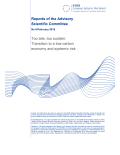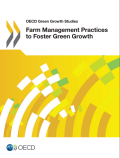
Keeping global warming below 2°C will require substantial reductions in global greenhouse gas emissions over the next few decades.
This report highlights that leaving the transition to a low-carbon economy too late risks affecting the economy of the European Union in three ways:
- first, a sudden transition away from fossil-fuel energy could harm GDP, as alternative sources of energy would be restricted in supply and more expensive at the margin;
- second, there could be a sudden repricing of carbon-intensive assets, which are financed in large part by debt;
- third, there could be a concomitant rise in the incidence of natural catastrophes related to climate change, raising general insurers’ and reinsurers’ liabilities.
A gradual transition to a low-carbon economy is therefore seen as the best option; this choice would be better manageable and would prevent energy costs from rising abruptly. Furthermore, additional policy intervention and investments in low-carbon technology are likely to help in preventing greenhouse gases in the atmosphere from growing in the medium term.


The “Intended nationally determined contributions” (INDCs) communicated by both developing and developed countries represent a crucial element of the Paris agreement. This brief aims at analysing the INDCs submitted by Parties, through the different tools and approaches proposed by the research community. In particular, our analysis looks at the different ways to assess the effectiveness of the proposed emission reduction pledges, both in terms of aggregate and national efforts. However, we also consider other factors that will be critical in determining the success of the Paris talks, such as the coherence and fairness of single contributions.

The global economy produces energy from two sources: a polluting non-renewable resource and a renewable resource. Transforming crude energy into ready-to-use energy services requires costly processes and more efficient energy transformation rates are more costly to achieve. Renewable energy is in competition with food production for land acreage but the food productivity rate of land can also be improved at some cost. The exploitation of non-renewable energy releases polluting emissions in the atmosphere. To avoid catastrophic climate damages, the pollution stock is mandated to stay below a given cap. In the interesting case where the economy would be constrained by the carbon cap at least temporarily, we show the following. When the economy is not constrained by the cap, the efficiency rates of energy transformation increase steadily until the transition toward the ultimate green economy; when renewable energy is exploited, its land acreage rises at the expense of food production; food productivity increases together with the land rent but food production drops; the prices of useful energy and food increase and renewables substitute for non-renewable energy.

Linking emissions trading schemes is the bottom-up approach to creating a global carbon market. It entails political compromise and a careful assessment of the trade-off between its advantages and disadvantage.
This article points out that the main benefits of linking are the reduction of the aggregate compliance and transactions costs, the reduction of the competitive distortions and the increase of market liquidity. On the other hand, the article identifies also drawbacks in this process: differences in certain design elements can challenge the environmental policy objectives through free-riding and emissions leakage. For all these reasons, a linking project requires solutions to harmonize those design elements which pose barriers to an effective linkage.
